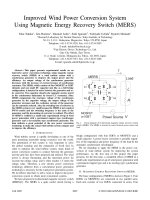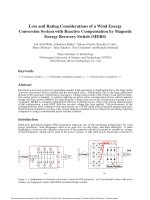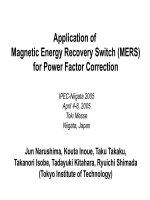- Trang chủ >>
- Khoa Học Tự Nhiên >>
- Vật lý
Tài liệu Magnetic resonance potx
Bạn đang xem bản rút gọn của tài liệu. Xem và tải ngay bản đầy đủ của tài liệu tại đây (658.99 KB, 14 trang )
Applied physics group,
Physics department, CBNU
Contents:
Introduction
Theory basis
The basis of experiments
Summary
Next slide
Applied physics group,
Physics department, CBNU
Magnetic resonance is a phenomenon found in
magnetic systems that
possess both magnetic moments and angular
momentum.
Magnetic resonance is an analytical technique
based on a property of
matter called spin.
Magnetic resonance techniques include:
Magnetic resonance imaging (MRI),
Nuclear magnetic resonance (NMR),
Electron spin resonance (ESR),
Electron paramagnetic resonance (EPR).
Magnetic resonance techniques are generally
non-invasive and non-destructive.
Next slide
Applied physics group,
Physics department, CBNU
Magnetic resonance technique applications
MRI is used by clinicians to produce
tomographic images of
the inside of the human body. MRI is also
used by scientists
to study materials as it is a non-destructive
imaging technique.
NMR is used by scientists to study the
structure and dynamics
of molecules.
ESR and EPR are used by scientists to study
structure and reactions of free radicals.
Next slide
Applied physics group,
Physics department, CBNU
Next slide
Applied physics group,
Physics department, CBNU
A system such as a nucleus may consist of many particles coupled
together so that in any given state, the nucleus possesses a total
magnetic moment µ and a total angular momentum J. Two vectors
may be taken as parallel
µ = γJ
where γ is a scalar called the “gyromagnetic ratio”
In quantum theory, we have
J = I
where I stands for a dimensionless angular momentum operator.
Next slide
Applied physics group,
Physics department, CBNU
As an external magnetic field is applied, this field produces an
interaction energy of nucleus of amount -µ H.
The Hamiltonian:
H = - µH
H = -γ H0Iz in the z-direction,
and E = γ H0m
with m = I, I-1, ….-I (2I + 1 values)
Next slide
Applied physics group,
Physics department, CBNU
m
H0
3 3
+1
2 2
-3/2
3 3
µH 0
2 2
-1/2
1 3
H
µ 0
2 2
+1/2
+3/2
0
1 3
− µH 0
2 2
3 3
− µH 0
2 2
The energy of the four sublevels of a nucleus with
spin I=3/2 when placed in a magnetic field H0
To satisfy the conservation of energy,
ω = ∆ E
∀ ∆E is the energy difference between the initial and final
nuclear Zeeman energies.
∀ ω is an angular frequency
Next slide
Applied physics group,
Physics department, CBNU
For producing magnetic resonance, an
alternating magnetic field is applied
perpendicularly to the static magnetic field,
and is written by
H pert= -γ H0x Ixcosω t
Consequently, the allowed transitions are
between levels adjacent in energy, giving
ω = ∆ E = γ H0
H
0
x
H0
or ω = γ H0
On the other hand, for a particle with mass m
and charge e moving in a circular path of
radius r with period T
J = mvr = m.2π r2/T
While the magnetic moment is
µ = iA,
because i = (e/c)(1/T),
we have µ = eπ r2/cT, then deducing γ =
e/2mc.
Next slide
Applied physics group,
Physics department, CBNU
Experiments
1
m =+
2
A
Oven
dH
dz
C
dH
=0
dz
1
m =−
2
B
dH
dz
Detector
1
m =+
2
Slit
The atomic beam arrangement of I. Rabi and collaborators used to
detect magnetic resonance transitions in atomic energy levels
Next slide
Applied physics group,
Physics department, CBNU
X -in
Electromagnet pole faces
Magnet
Power
supply
X–Y
recorder
B
Y -in
Keithley
610A
D
Crystal
Magic
T
Cavity and
sample
A
Sync in
Microwave
Oscillator
And power supply
C
Dummy
load
Schematic arrangement of apparatus for an electron
paramagnetic resonance experiment in the
microwave region.
Next slide
Applied physics group,
Physics department, CBNU
Conclusion
With a large masses have low γ’s, a factor of 1000
lower γ for nuclei than for electrons.
We can change ω by changing Ho, but in most
cases it is advantageous to use as large a magnetic
field as possible.
The electronic systems have a resonance in the
microwave frequency region.
The nuclear systems have a resonance in the radio
frequency region.
Next slide
Applied physics group,
Physics department, CBNU
Next slide
Applied physics group,
Physics department, CBNU
Thanks for your attention!
The end









